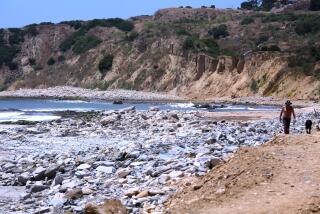Natural Habitat Reconstruction
Recent news articles reported a search for natural habitats that could be improved or built to offset the destruction of wetlands by the ports of Los Angeles and Long Beach. Among habitats being considered are new artificial reefs off the local coastline, but such reefs do not meet federal and state criteria and do not compete with tide pools in the production of flora and fauna.
The best habitat to reconstruct is the beach, tidal and sub-tidal areas in the Abalone Cove-Portuguese Bend landslide areas. About two miles of coastline have been severely damaged and neglected for years. The sand beaches and productive tide pool areas have been replaced or covered with landslide debris consisting of small rocks and cobbles that support very little sea life. The sub-tidal area that was reef rock and sand is now covered with silt mud that has smothered most of the flora and fauna. Near-shore sea life can’t compete with loose rocks and mud.
Let’s rectify the damage that started in 1956. State and federal laws require that habitats destroyed by planned port construction be offset by repairing conditions elsewhere--in this case, the Portuguese Bend and Abalone Cove areas.
The repair of the Portuguese Bend coastal area (splash zone, tidal and sub-tidal areas) involving 100 acres will very likely be as valuable to the ocean environment as the Seal Beach (Naval) Weapons Station wetlands reconstruction.
WILLIAM R. GRIFFIN
Rancho Palos Verdes
More to Read
Sign up for Essential California
The most important California stories and recommendations in your inbox every morning.
You may occasionally receive promotional content from the Los Angeles Times.










